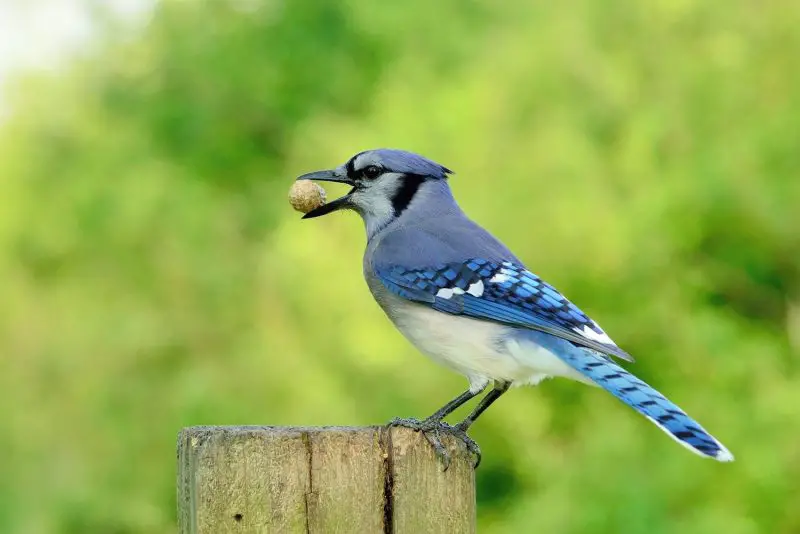Illinois is home to a diverse array of bird species, and among them, the blue jay stands out as one of the most vibrant and fascinating. Recognized for their striking blue plumage, raucous calls, and intelligent behaviors, blue jays capture the attention of both casual observers and avid birdwatchers. These birds are more than just beautiful; they play an essential role in local ecosystems, acting as seed dispersers and alerting other wildlife to potential threats. In Illinois, their presence can be found across forests, parks, and even suburban backyards, making them highly accessible for observation and study. Understanding the different types of blue jays, their habits, and the best locations to watch them can greatly enhance the experience of birdwatching in the state.
The blue jay’s complex social behaviors, distinct vocalizations, and adaptability make them an intriguing subject for ornithologists and enthusiasts alike. These birds are not only admired for their aesthetic appeal but also for their remarkable intelligence and intricate interactions with their surroundings. In Illinois, the blue jay population thrives due to the state’s mix of deciduous forests, open woodlands, and urban green spaces. By exploring the types of blue jays, their identification markers, dietary preferences, breeding habits, and unique behaviors, one can gain a deeper appreciation for this charismatic species and learn how to locate them in their natural habitats.
Types of Blue Jays in Illinois

In Illinois, the primary species of blue jay is the Eastern Blue Jay (Cyanocitta cristata). This species is widespread across the state and is easily recognizable due to its vivid coloration and dynamic behavior. While there are occasional variations in plumage brightness and subtle regional differences, the Eastern Blue Jay dominates the landscape of Illinois. Unlike some regions that may host multiple subspecies or related jay species, Illinois primarily features this single, highly adaptable species.
Eastern Blue Jays are part of the Corvidae family, which also includes crows, ravens, and magpies. Their intelligence is notable, often compared to that of some primates, especially in problem-solving and social interaction. Despite being one species, they can display diverse behaviors depending on the habitat, season, and availability of food. For birdwatchers, this variability adds an element of unpredictability, making each encounter with blue jays a unique experience.
Identification and Physical Characteristics
The Eastern Blue Jay is easily identified by its striking plumage and crest. The upperparts of the bird are a bright blue, while the underparts are predominantly white or light gray. A black “necklace” extends around the throat, and the face is framed with a thin black line extending from the base of the bill through the eyes. Their wings and tail feature black, white, and blue barring that can be particularly eye-catching in flight.
Blue jays are medium-sized birds, typically measuring between 9 to 12 inches in length, with a wingspan of approximately 13 to 17 inches. Adults usually weigh around 2.5 to 3.5 ounces. They possess strong, slightly curved bills and sturdy legs, which are well-suited for foraging and perching. The crest on their head is flexible, allowing them to signal mood or aggression. A raised crest often indicates alertness or excitement, while a lowered crest suggests calmness.
Vocalizations and Communication
Blue jays are renowned for their wide range of vocalizations, which include loud, harsh calls, musical notes, and even mimicry of other birds. The most familiar call is the “jay-jay” sound, often used to communicate alarm or establish territory. They are also capable of mimicking hawks, particularly the Red-shouldered Hawk, which they use to deceive other birds or signal potential danger.
Communication among blue jays is highly sophisticated. They use vocal cues to coordinate group movements, warn of predators, and engage in playful social interactions. Observing these vocalizations in the wild can provide insight into their behavior and social hierarchy. In Illinois, their calls are especially prominent during the early morning and late afternoon, coinciding with peak activity periods.
Habitat and Distribution
Eastern Blue Jays are highly adaptable and occupy a wide range of habitats throughout Illinois. They are commonly found in deciduous and mixed forests, forest edges, parks, and suburban neighborhoods. These birds prefer areas with large trees for nesting and ample food sources such as acorns, seeds, and insects.
In urban and suburban settings, blue jays readily visit bird feeders, often displaying bold and curious behavior. Their ability to thrive in both natural and human-altered environments underscores their ecological flexibility. Seasonal changes may prompt minor shifts in distribution, with some individuals moving short distances to find abundant food or suitable nesting sites.
Feeding Habits and Diet
Blue jays have an omnivorous diet that reflects their opportunistic nature. Acorns, nuts, seeds, berries, and insects form the bulk of their diet. They are known to cache food in various locations, a behavior that aids survival during winter months when food is scarce. This caching behavior also inadvertently supports forest regeneration, as some buried acorns germinate and grow into new trees.
In Illinois, blue jays can be observed foraging both on the ground and in trees. They often exhibit methodical searching behavior, hopping between branches or walking along the forest floor. They are also attracted to backyard feeders, particularly those offering peanuts, sunflower seeds, and suet, which makes them accessible to birdwatchers.
Breeding and Reproduction
The breeding season for blue jays in Illinois typically begins in late March and continues through July. They form monogamous pairs for the season, with both parents participating in nest building, incubation, and chick rearing. Nests are generally constructed high in the branches of deciduous trees, using twigs, grasses, and mud to form a sturdy structure.
Clutch size usually ranges from three to six eggs, which are pale blue or greenish with brown speckles. Both parents share incubation duties, which lasts about 16 to 18 days. After hatching, chicks are altricial, meaning they are born helpless and require intensive care. Parents feed the young a diet rich in insects and soft foods, gradually introducing them to seeds and nuts as they mature. By three weeks, the fledglings are ready to leave the nest but often remain nearby, learning essential survival skills.
Behavior and Social Dynamics
Blue jays exhibit complex social behaviors and are often seen in small family groups or loose flocks. They are territorial during the breeding season, vigorously defending nests from intruders. Outside of breeding periods, they may form larger congregations, especially in areas with abundant food.
Their intelligence is evident in behaviors such as problem-solving, tool use, and food caching. Blue jays are also known for their playful interactions, which include chasing, aerial acrobatics, and mock fights. These behaviors not only strengthen social bonds but also improve survival skills among younger birds.
Fun Facts About Blue Jays
Several fascinating aspects of blue jay biology contribute to their allure. They possess an extraordinary memory for locations where they have cached food. They are also capable of recognizing individual humans and may react differently to familiar versus unfamiliar people. Additionally, their mimicry of hawks serves as both a protective mechanism and a strategy to manipulate other birds.
Blue jays have inspired folklore and cultural references, often symbolizing intelligence, resourcefulness, and communication. Their vibrant blue coloration is due not to pigments but to structural coloration, where the microscopic structure of feathers refracts light to produce the vivid blue hue.
Top Locations to Watch Blue Jays in Illinois
Illinois offers numerous prime locations for observing blue jays. Forested areas such as Starved Rock State Park provide ideal natural habitats, where birdwatchers can spot these birds among mature trees and along wooded trails. Shawnee National Forest in southern Illinois is another excellent site, with large tracts of deciduous forest and abundant food sources.
Urban parks and suburban areas also provide excellent viewing opportunities. Chicago’s Lincoln Park and various forest preserves in the metropolitan area attract blue jays to feeders and bird-friendly landscapes. Early morning or late afternoon tends to be the most active time for observation, and quiet patience often yields the best sightings.
Seasonal migration can affect where blue jays are seen in Illinois. While many are year-round residents, some individuals move to find food or milder winter climates. This dynamic presence ensures that birdwatchers can enjoy varied encounters throughout the year.
Conclusion
Blue jays in Illinois are a captivating and highly adaptable species, renowned for their striking appearance, intelligence, and complex social behaviors. The Eastern Blue Jay dominates the state’s landscapes, thriving in forests, parks, and suburban environments. Their vocalizations, foraging habits, breeding strategies, and playful interactions make them a favorite among birdwatchers and ornithologists alike.
For those seeking to observe these birds, Illinois provides diverse opportunities, from natural forests like Starved Rock and Shawnee National Forest to urban parks and backyard feeders. Understanding their types, habits, and preferred habitats enriches the experience of watching these vibrant birds and deepens appreciation for their role in local ecosystems. By exploring the fascinating world of blue jays, bird enthusiasts can enjoy a lifetime of discovery, learning, and connection with nature.
FAQs about Blue Jays in Illinois
What types of blue jays are found in Illinois?
The primary species of blue jay in Illinois is the Eastern Blue Jay (Cyanocitta cristata). While occasional variations in plumage occur, this species dominates the state and is easily recognizable by its bright blue feathers, black necklace, and striking crest.
How can I identify a blue jay?
Blue jays are medium-sized birds measuring 9 to 12 inches in length with a wingspan of 13 to 17 inches. They feature bright blue upperparts, white underparts, black markings around the face and neck, and a distinctive crest on their head. Their wings and tail show black, white, and blue barring.
What do blue jays eat in Illinois?
Blue jays are omnivorous. Their diet includes acorns, nuts, seeds, berries, and insects. They are known for caching food, which helps them survive during winter and also contributes to forest regeneration.
Where can I watch blue jays in Illinois?
Blue jays can be observed in forests, parks, and suburban areas. Prime locations include Starved Rock State Park, Shawnee National Forest, and urban green spaces like Lincoln Park in Chicago. Early morning and late afternoon are ideal times for sightings.
How do blue jays communicate?
Blue jays have a wide range of vocalizations, including the familiar “jay-jay” calls and mimicry of hawks. They use these sounds to signal danger, coordinate group movements, and interact socially. Their communication is highly intelligent and complex.
When is blue jay breeding season in Illinois?
The breeding season typically starts in late March and continues through July. Pairs form monogamous bonds for the season, build nests high in deciduous trees, and raise three to six chicks, which fledge after about three weeks.
Are blue jays intelligent birds?
Yes, blue jays are considered highly intelligent. They exhibit problem-solving skills, use tools occasionally, have excellent memory for cached food, and can even recognize individual humans. Their intelligence is comparable to some primates among bird species.
Do blue jays migrate in Illinois?
Most Eastern Blue Jays are year-round residents in Illinois. However, some individuals may move short distances seasonally to find food or milder conditions. Migration patterns can be unpredictable, leading to varied sightings throughout the year.






